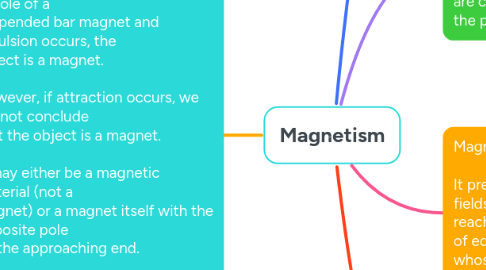
1. How is a magnet identified? If an object is moved towards the N pole of a suspended bar magnet and repulsion occurs, the object is a magnet. However, if attraction occurs, we cannot conclude that the object is a magnet. It may either be a magnetic material (not a magnet) or a magnet itself with the opposite pole on the approaching end. Repulsion is the only test to confirm that an object is a magnet.
1.1. Magnetic Fields A magnetic field is the region surrounding a magnet, in which a body of magnetic material experiences a magnetic force.
1.1.1. Magnetisation 1. Stroking 2. Electrical method using direct current
1.1.2. Demagnetising Magnets This can be done in three ways. 1. Heating 2. Hammering 3. Electrical method using an alternating current
1.1.2.1. Uses of Magnets Permanent magnet The magnetic door catch of a refrigerator ensures it is airtight. Temporary magnet Electromagnets are used to separate magnetic materials from non-magnetic materials in a scrapyard.
1.2. Magnetic Field Pattern Around a Straight Wire Consider a straight, current-carrying wire placed vertically through a sheet of cardboard. The magnetic field of a straight, current-carrying wire consists of concentric circles. The magnetic field is stronger closer to the wire. Magnetic Field Pattern Around a Straight Wire We can predict the direction of the magnetic field around the wire using the right-hand grip rule. The direction of the magnetic field of a current-carrying wire reverses when the direction of the current is reversed.
1.2.1. The strength of the magnetic field of a current-carrying wire increases when the current is increased. I1 < I2 Magnetic Field Pattern of a Solenoid The magnetic field pattern of a solenoid resembles that of a bar magnet. N S The solenoid has two poles and can be used as an electromagnet. Ways to increase the strength of an electromagnet increasing the current; increasing the number of turns per unit length of the solenoid; placing a soft iron core within the solenoid.
1.2.1.1. Circuit Breakers A circuit breaker is a safety device that switches off the electrical supply when there is excessive current flow. One of the core components of the circuit breaker is the electromagnet. Circuit breakers are an application of electromagnetism.
1.2.1.1.1. Switch is closed ➊ ➍ Short circuit or overloading ➎ Magnetic field produced by solenoid is strong Circuit Breakers circuit breaker when current is excessive Surge in current Soft iron latch attracted to solenoid Circuit Breakers ➏Spring is released Safety bar is pushed outwards such that switch is in‘off’position Interrupt point is open Circuit is broken
